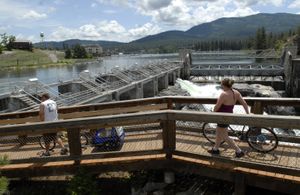Avista dropping Spokane River flows to minimum 500 cfs
DROUGHT -- In a last-ditch effort to maintain negotiated summer water levels at Lake Coeur d'Alene, Avista is reducing Spokane River flows out of Post Falls Dam to the absolute minimum of 500 cubic feet per second.
The median flow for this time of year is about 2,000 cfs.
"The Federal Energy Regulatory Commission (FERC) license governing Avista’s Spokane River Project operations was issued in 2009, balancing the needs of all water users," Avista said in a just-posted release. "This balance takes into account Coeur d’Alene Lake’s water levels and the Spokane River flows downstream of Post Falls, among other issues."
It's just the latest sobering news about record-low river flows across the West stemming from a low snowpack in the mountains.
Here's the rest of Avista's release:
In compliance with the FERC license, Avista expects that the Post Falls Hydroelectric Development (HED) will begin discharging the minimum of 500 cubic feet per second this weekend or early next week. This will help maintain Coeur d’Alene Lake levels as well as keep water in the Spokane River throughout the rest of the summer.
The Idaho Department of Environmental Quality, the Washington Department of Ecology, and Avista would like to advise our community that very poor snowpack in the entire Spokane river watershed, combined with continued hot, dry weather has reduced water levels in Coeur d’Alene Lake, as well as flows in the Spokane River.
Avista’s FERC license, based on studies and collaborative negotiations including many parties over several years, carefully balances Coeur d’Alene Lake levels and downstream river flows. These requirements take into account fisheries and water quality, as well as public recreation. Avista’s prior FERC license included a much lower required discharge, and no reference to lake level management. Avista worked with agencies, tribes, local governments and citizens groups to plan the current operations of Post Falls (HED) as they impact Coeur d’Alene Lake and the Spokane River.
“In dry years like this, the connection between the aquifer and the river becomes quite clear,” said Guy Gregory, Senior Hydrogeologist for Ecology’s Eastern Region Water Resources Program. “Water use by people directly affects river flows. That’s why we hope people will use water wisely and efficiently. Fix a leak, don’t water the sidewalk and pay attention to how much you irrigate. It matters.”
River recreationists can monitor flows by visiting avistautilities.com/waterflow when planning water-related activities.
Click here for tips on warm-weather fishing and a fly fishing report from Silver Bow Fly Shop.
